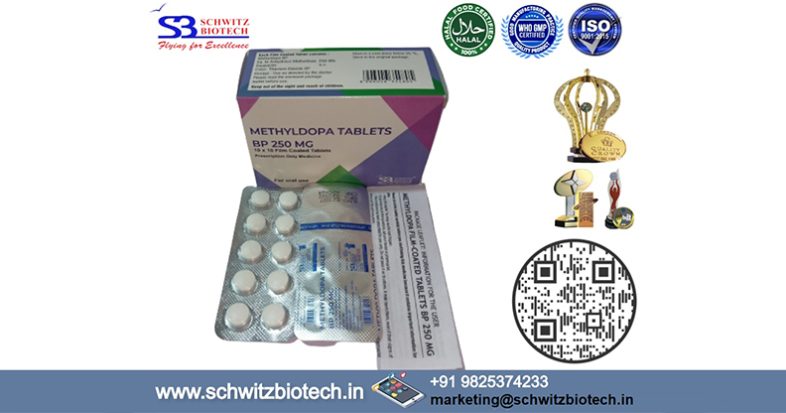METHYLODOPA TABLET

METHYLDOPA TABLETS BP 250 MG
Read all of this leaflet carefully before you start taking this medicine because it contains important information for you.
- Keep this leaflet. You may need to read it again.
- If you have any further questions, ask your doctor or pharmacist.
- This medicine has been prescribed for you only. Do not pass it on toothers. It may harm them, even if their signs of illness are thesame as yours.
- If you get any side effects, or if you notice any side effects not listedin this leaflet, please tell your doctor or pharmacist or nurse.
- This includes any possible side effects not listed in this leaflet. SeeSection 4.
WHAT IS IN THIS LEAFLET
- What Aldomet is and what it is used for
- What you need to know before you take Aldomet
- How to take Aldomet
- Possible side effects
- How to store Aldomet
- Contents of the pack and other information
1. WHAT METHYLDOPA TABLETS ARE AND WHAT THEY ARE USED FOR
Methyldopa belongs to a group of medicines called antihypertensive, which lower blood pressure. Methyldopa tablets are used to treat high blood pressure (hypertension).
2. WHAT YOU NEED TO KNOW BEFORE YOU TAKE METHYLDOPA TABLETS
Do not take Methyldopa tablets and tell your doctor if you:
- are allergic (hypersensitive) to methyldopa or any of the other ingredients (see section 6)
- have liver disease
- have high blood pressure due to a tumour near the kidney (phaeochromocytoma or paraganglioma)
- suffer from depression
- are taking MAOIs (monoamine oxidase inhibitors) for depression
- or a relative have a genetic/inherited disorder of the red blood pigment haemoglobin (porphyria).
WARNINGS AND PRECAUTIONS
Check with your doctor or pharmacist before taking Methyldopa tablets if you:
- have had liver disease
- have kidney disease (dialysis removes methyldopa so hypertension may recur)
- have damaged or diseased blood vessels in your brain
- start to show symptoms of reduced blood cells including pale skin, jaundice, infection, fever, weakness, unexpected bruising or bleeding, headaches (acquired haemolytic anaemia (indicated by a positive Coombs test), leucopenia and thrombocytopenia are all reversible on stopping methyldopa treatment).
OTHER MEDICINES AND METHYLDOPA TABLETS
Please tell your doctor or pharmacist if you are taking, have recently taken or might take any other medicines, including medicines obtained without a prescription. Especially
- alprostadil used to treat erectile dysfunction
- antihypertensive medicines used to treat high blood pressure (e.g. propranolol, nifedipine, verapamil or ‘water tablets’)
- medicines to treat Parkinson’s disease such as levodopa, entacapone
- lithium (used to treat depression and mental illness)
- MAOIs (mono-amine oxidase inhibitors) used to treat depression (e.g. phenelzine)
- medicines to treat mental illness (e.g. chlorpromazine)
- moxisylyte used to treat Raynaud’s syndrome
- muscle relaxants such as baclofen, tizanidine
- nitrates (e.g. glycerol trinitrate “GTN”, isosorbide dinitrate/ mononitrate)
- iron supplements
METHYLDOPA WITH ALCOHOL
- You are advised not to drink alcohol with this medicine. Discuss this with your doctor if you have any questions.
PREGNANCY AND BREAST-FEEDING
- If you are pregnant or breast-feeding, think you may be pregnant or are planning to have a baby, ask your doctor or pharmacist for advice before taking this medicine.
DRIVING AND USING MACHINES
- Methyldopa tablets may make you feel drowsy. Make sure you are not affected before you drive or operate machinery.
BLOOD TESTS
- Methyldopa may affect the results of certain laboratory tests. Regular checks (before the start of treatment and 6-12 weeks later) may be carried out on blood cells and liver function (blood test to show your liver is working).
SURGERY
- If you have to have surgery, including dental, that requires an anaesthetic let them know what medicines you are taking.
3. HOW TO TAKE METHYLDOPA TABLETS
- Always take Methyldopa tablets exactly as your doctor has told you. If you are not sure, check with your doctor or pharmacist
DOSES
- Adults and children over 12 years: Initially 250mg two or three times a day, for 2 days. Then increased every 2 or more days until an adequate response is achieved up to a maximum of 3g daily.
CHILDREN UNDER 12 YEARS
- Initially 10mg per kg of bodyweight daily in 2-4 divided doses adjusted as required up to 65mg/kg or 3g daily, whichever is less.
ELDERLY
- Initially no more than 250mg a day (e.g. 125mg twice daily), increasing up to a maximum of 2g a day.
- Methyldopa may be given with, or instead of, other medicines to lower blood pressure and the doses may need to be amended.
IF YOU TAKE MORE METHYLDOPA TABLETS THAN YOU SHOULD
If you (or someone else) swallow a lot of the tablets at the same time, or if you think a child may have swallowed any, contact your nearest hospital casualty department or tell your doctor immediately. Symptoms of an overdose include excessive drowsiness, weakness, slow heart rate, low blood pressure, dizziness, light-headedness, painful infrequent bowel movements, bloated feeling, wind, diarrhoea, feeling or being sick.
IF YOU FORGET TO TAKE METHYLDOPA TABLETS
Do not take a double dose to make up for a forgotten dose. If you forget to take a dose take it as soon as you remember it and then take the next dose at the right time.
IF YOU STOP TAKING METHYLDOPA TABLETS
Do not stop treatment early because an increase in blood pressure may occur. Talk to your doctor before you stop taking the tablets and follow their advice.
4. POSSIBLE SIDE EFFECTS
Like all medicines, this medicine can cause side effects, although not everybody gets them.
4. POSSIBLE SIDE EFFECTS
Like all medicines, this medicine can cause side effects, although not everybody gets them.
Severe allergic reaction (rash, itching, swelling of the face, lips, mouth or throat that may cause difficulty in swallowing or breathing). This is a serious but rare side effect (may affect up to 1 in 1, 000 people).
Fever; severe rash involving reddening, peeling and swelling of the skin that resembles severe burns (toxic epidermal necrolysis); chest pain, worsening of existing angina, problems with the electrical current in the heart (AV block); abnormal liver function including hepatitis and jaundice (yellowing of the skin and/or whites of the eyes). These would be detected by a blood test; inflammation of the bowel (colitis); inflammation of the pancreas (pancreatitis).
The following side effects have also been reported: Not known (frequency cannot be estimated from the available data):
Blood: your medicine may alter the numbers and types of your blood cells and cause a rise in urea in the blood. If you notice increased bruising, nosebleeds, sore throats, infections or fever, you should tell your doctor who may want to give you a blood test.
Central nervous system: drowsiness (usually lasts a few days at start of treatment or after an increased dose), headache, loss of strength or weakness, tingling or pins and needles, trembling and shuffling walk, partial paralysis of the face, involuntary jerky movements, mental changes including nightmares, confusion, mild depression, dizziness, light-headedness, reduced blood flow to the brain.
Heart: slow heart rate and low blood pressure, low blood pressure causing dizziness on standing, water retention causing swelling and weight gain.
Respiratory system: blocked/stuffy nose. Stomach and intestines: feeling or being sick, bloated stomach, constipation, wind, diarrhoea, mild dryness of the mouth, sore or “black” tongue, inflamed salivary glands.
Skin: eczema, hard skin rash (lichenoid), swelling in the face, tongue, larynx, abdomen, or arms and legs, hives.
Muscles and bones: mild joint pain with or without swelling. Muscle pain or cramps
Reproductive system and breasts: absence of periods, swelling of breasts in men and women, abnormal production of breast milk, failure to ejaculate, decreased sex drive, failure to maintain an erection (impotence).
Severe allergic reaction (rash, itching, swelling of the face, lips, mouth or throat that may cause difficulty in swallowing or breathing). This is a serious but rare side effect (may affect up to 1 in 1, 000 people).
Fever; severe rash involving reddening, peeling and swelling of the skin that resembles severe burns (toxic epidermal necrolysis); chest pain, worsening of existing angina, problems with the electrical current in the heart (AV block); abnormal liver function including hepatitis and jaundice (yellowing of the skin and/or whites of the eyes). These would be detected by a blood test; inflammation of the bowel (colitis); inflammation of the pancreas (pancreatitis).
The following side effects have also been reported: Not known (frequency cannot be estimated from the available data):
Blood: your medicine may alter the numbers and types of your blood cells and cause a rise in urea in the blood. If you notice increased bruising, nosebleeds, sore throats, infections or fever, you should tell your doctor who may want to give you a blood test.
Central nervous system: drowsiness (usually lasts a few days at start of treatment or after an increased dose), headache, loss of strength or weakness, tingling or pins and needles, trembling and shuffling walk, partial paralysis of the face, involuntary jerky movements, mental changes including nightmares, confusion, mild depression, dizziness, light-headedness, reduced blood flow to the brain.
Heart: slow heart rate and low blood pressure, low blood pressure causing dizziness on standing, water retention causing swelling and weight gain.
Respiratory system: blocked/stuffy nose. Stomach and intestines: feeling or being sick, bloated stomach, constipation, wind, diarrhoea, mild dryness of the mouth, sore or “black” tongue, inflamed salivary glands.
Skin: eczema, hard skin rash (lichenoid), swelling in the face, tongue, larynx, abdomen, or arms and legs, hives.
Muscles and bones: mild joint pain with or without swelling. Muscle pain or cramps
Reproductive system and breasts: absence of periods, swelling of breasts in men and women, abnormal production of breast milk, failure to ejaculate, decreased sex drive, failure to maintain an erection (impotence).
TELL YOUR DOCTOR
Immediately or go to the casualty department of your nearest hospital if you experience any of the following serious side effects:
5. HOW TO STORE METHYLDOPA TABLETS
- Keep out of the sight and reach of children.
- Store below 25°C in a dry place. Protect from light.
- Do not use Methyldopa tablets after the expiry date stated on the label/carton/bottle. The expiry date refers to the last day of that month.
- Medicines should not be disposed of via wastewater or household waste. Ask your pharmacist how to dispose of medicines no longer required. These measures will help to protect the environment.
6. CONTENTS OF THE PACK AND OTHER INFORMATION WHAT METHYLDOPA TABLETS CONTAIN
- The active substance (the ingredient that makes the tablet work) is anhydrous methyldopa.
- Each film-coated tablet contains either 250mg of the active substance.
OTHER INGREDIENTS
Cellulose powder, anhydrous citric acid, colloidal anhydrous silica, ethylcellulose,guar gum, magnesium stearate, sodium calciumedetate, hypromellose, propylene glycol, quinoline yellow aluminium lake E104,red iron oxide E172, talc, titanium dioxide, citric acidmonohydrate.
WHAT METHYLDOPA TABLETS LOOKS LIKE AND CONTENTS OF THE PACK
Methyldopa tablets is yellow-coloured, round tablets containingmethyldopa equivalent to either 250 mg anhydrous methyldopa, or 500 mg anhydrousmethyldopa. Methyldopa tablets250 mg are available in packs of 60.

